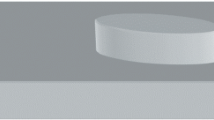Abstract
Both the nucleation process per se and the organization of nearby nuclei or precipitates formed at a given disordered grain boundary into a viable cell structure are considered. When the critical nucleus is modeled in simple fashion, based upon a rectangular parallelepiped, the rate of nucleation by the “conventional” mechanism, in which the grain boundary is essentially immobile during the nucleation process, far exceeds that by the Tu-Turnbull “pucker” mechanism, in which the grain boundary is deflected so that its plane is parallel to the habit plane of the nucleus. A more rigorous model of the critical nucleus, based upon the somewhat specialized assumption that an energy cusp facet forms at only one boundary orientation but developed without a preconceived view of the nucleus morphology, leads to this result only when the facet energy is greater than one-half the energy of a disordered grain boundary. In the reverse energetic situation, the nucleus morphology is effectively that supposed by the pucker mechanism. The initial stage of cellular growth is examined in the framework of the question: why do allotriomorphs form at disordered grain boundaries under some conditions of alloy composition and temperature and cells develop under other conditions? The conditions for the two reaction paths are established on the basis of two key ideas: the direction in which the torque term associated with a facet deflects a grain boundary meeting the edge of the facet (deduced from the considerations of Hoffman and Cahn), and the existence of a driving force for the breakaway of a grain boundary from such a junction resulting from the requirement of continuity of path to another junction located nearby.
Similar content being viewed by others
Reference
K. N. Tu and D. Turnbull:Acta Met., 1967, vol. 15, p. 369.
K. N. Tu and D. Turnbull:Acta Met., 1967, vol. 15, p. 1317.
R. Fournelle and J. B. Clark:Met. Trans., 1972, vol. 3, p. 2757.
K. C. Russell: inPhase Transformations, p. 219, American Society for Metals, New York, 1970.
D. Turnbull and H. Treaftis:Acta Met., 1955, vol. 3, p. 43.
R. S.Burington:Handbook of Mathematical Tables and Formulas, p. 7, Hand-book Publishers, Inc., Sandusky, Ohio, 1950.
K.C.Russell:Acta Met., 1968,vol. 16, p. 761.
K. C.Russell:Acta Met., 1969, vol. 17, p. 1123.
K. C. Russell: M.I.T., Cambridge, Mass., private communication, 1970.
J. Feder, K. C. Russell, J. Lothe and G. M. Pound:Advan. Phys., 1966, vol. 15, p.lll.
P. G.Shewmon:Diffusion in Solids, p. 65 and 171, McGraw-Hill, New York, 1963.
H. I. Aaronson, C. Laird, and K. R. Kinsman: inPhase Transformations, p. 313, American Society for Metals, Metals Park, Ohio, 1970.
D. W. Hoffman and J. W. Cahn:Surface Science, in press.
H. I.Aaronson: inDecomposition of Austenite by Diffusional Processes, p. 387, Interscience Publishers, New York, 1962.
H. I.Aaronson: inThe Mechanism of Phase Transformations in Metals, p. 47, The Institute of Metals, London, 1955.
C. S.Smith:Trans. ASM, 1964, vol. 45, p. 533.
G. R.Speich:Trans. TMS-AIME, 1963, vol. 227, p. 754.
C. Laird and H.I. Aaronson:Acta Met., 1967,vol. 15,p.73.
Author information
Authors and Affiliations
Additional information
H.I. AARONSON and H. B. AARON, formerly with the Metallurgy Department, Scientific Research Staff, Ford Motor Company, Dearborn, Mich. 48121
This paper is based on a presentation made at a symposium on “The Cellular and the Pearlite Reactions,” held at the Detroit Meeting of The Metallurgical Society of AIME, October 20, 1971, under the sponsorship of the IMD Heat Treatment Committee.
Rights and permissions
About this article
Cite this article
Aaronson, H.I., Aaron, H.B. The initial stages of the cellular reaction. Metall Trans 3, 2743–2756 (1972). https://doi.org/10.1007/BF02652841
Published:
Issue Date:
DOI: https://doi.org/10.1007/BF02652841




